
Friday, May 30, 2008
Xactly Incent 4.0 - Effective Dating and Other New Features

Enterprise Incentive Management News
Xactly Wins Coveted 2008 CODiE Award
Sales performance management leader takes home software industry's top honor for best financial software solution
XACTLY NAMED TOP FINALIST FOR 2008 AMERICAN BUSINESS AWARDS(SM)
Leading on-demand sales performance management vendor chosen from among 2,600 entries for prestigious Stevie® Awards
Callidus
Sierra Atlantic Partners With Callidus Software to Advance Software-as-a-Service (SaaS) Delivery
Provides Global Delivery Model to Achieve Sales Performance Management Growth
Centive
Centive Named to JMP Securities' Hot 100 Software Companies
"We are pleased to be honored with inclusion in the Hot 100 report by JMPSecurities," said Michael Torto, president and CEO, Centive.
Centive Named as Finalist in 2008 American Business Awards
On-Demand Sales Compensation Management Leader Recognized for Providing Exceptional Customer Service
Tuesday, May 27, 2008
Networking 2.0 - The Art of Making Connections
 I'm deviating a bit from the incentive, compensation and sales performance management topics to talk about professional networking. I was invited by a Canadian Heritage Network (Generaction) to be a keynote speaker at an event next Thursday (May 29, 2008) in Ottawa. The topic of my presentation is "Networking 2.0 - The Art of Making Connections". You can download my Power Point presentation here.
I'm deviating a bit from the incentive, compensation and sales performance management topics to talk about professional networking. I was invited by a Canadian Heritage Network (Generaction) to be a keynote speaker at an event next Thursday (May 29, 2008) in Ottawa. The topic of my presentation is "Networking 2.0 - The Art of Making Connections". You can download my Power Point presentation here.- Never Eat Alone and Other Secrets to Success One Relationship at a Time by Keith Ferrazzi
- Dig your Well Before You're Thirsty by Harvey Mackay
- Wikinomics: How Mass Collaboration Changes Everything by Don Tapscott
Monday, May 26, 2008
For Love or Money: Social vs Monetary Reward
 Social Status and cash activate the same reward centre in the brain. That's what two papers in the latest Neuron journal (Volume 58, Issue 2) are saying. I'm always very interested by cognitive research attempting to explain how certain activities can affect human behavior.
Social Status and cash activate the same reward centre in the brain. That's what two papers in the latest Neuron journal (Volume 58, Issue 2) are saying. I'm always very interested by cognitive research attempting to explain how certain activities can affect human behavior.The article "Know Your Place: Neural Processing of Social Hierarchy in Humans" by Dr. Caroline Zink and colleagues explains how information about social status activated the same brain regions.
The second article "Processing of Social and Monetary Rewards in the Human Striatum" by Dr. Norihiro Sadato supports how reputation affects people in the same way as money does.
A subscription is required to read those articles, but they were summarized in ABC Science article "Praise or Cash? Your brain doesn't care".
Personal Story:
These studies support my own view on the topic. Last month I discussed the impact of the size of a money bonus on performance. It would be very interesting to see a similar experiment where some a group receive a lot of encouragement and the other group receives no praise at all, to compare their performance.
One of my previous employers, as many employers do, offered an annual performance bonus. This bonus was a percentage of the annual salary, but every employee received a very similar bonus. Employees developed a sense of entitlement to this bonus, and always thought they had met all their performance objectives and deserved the full amount. I'm just giving this context to illustrate how the cash incentive most likely did not have a positive impact on performance.
The employer, aware of this problem, introduced a "praise" program, consisting of recognizing employees who had made a significant contribution. Managers were encouraged to simply give a "Thank You" card to exceptional employees. I have no idea how this program affected performance... But it's impact on motivation was priceless.
Employees receiving these "praises" would shine for weeks. Common sense tells me that motivation can easily be correlated to performance. I can safely say that the thank you notes I received from colleagues I had helped during evenings and weekends really motivated me to keep working hard - there is nothing like feeling appreciated!
Another Story on Social Status
A few weeks ago I read an article about how job titles could be used to motivate employees, even if no pay increase is associated with the new title. I have a friend who had his job title changed from "Business Dev Manager" to "Manager, Entrepreneurship and Innovation Development". He's been jumping up and down since he got this "promotion". His reasons for being so happy: the title is unique, distinguishes him from his peers, and sounds better from his perspective.
Thursday, May 22, 2008
SPM Testing Template - Part 5
Here is an example to get started:
Other benefits of using an Excel spreadsheet to record test results instead of a Word document include:
- Ability to quickly highlight failing tests in red
- Ability to filter information displayed (e.g. display only failing tests)
- Test results can be printed on fewer pages
- Ability to create macros to perform more "fancy" features such as displaying the number of days a certain issue has been opened.
Wednesday, May 21, 2008
PlanIt: Another On-Demand Sales Performance Solution
Sales Resource Group Inc. is an industry leading sales compensation professional services organization that provides world class software, consulting and outsourcing services, with expertise in sales incentive programs and sales force effectiveness.I had heard about their president David Johnston before, from his articles in the Canadian Professional Sales Association (CPSA) Contact magazine. David has over 20 years experience consulting for various organizations and teaches sales compensation for WorldatWork.
What distinguishes Sales Resource Group from many other small sales compensation management companies is that they offer their own sales compensation solution called "PlanIt".
PlanIt is an On-Demand Sales Performance Management solution offering the same functionalities as other applications in its category (incentive calculations, reporting, analytics, etc). In addition, PlanIt also has a module providing guidance to optimize compensation programs and align these programs to business needs, and allows to route relevant documentation to its users.
User Interface
Similar to other applications, PlanIt displays some high level compensation information to the payees when they login. From this screen they can easily review their current revenues, the top 10 performers and their ranking compared to their peers. What I particularly like about the main screen is the News /Announcements which occupies an important position at the top center of the screen. This ensures payees don't miss out on important news.
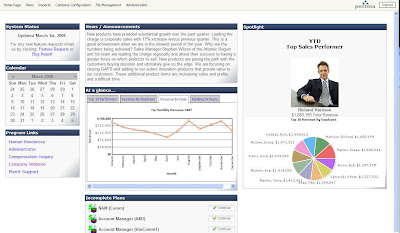
Reporting
The reporting section is also very important for the payees. Most of the reports are available "out-of-the-box" and illustrate all the information in different level of details. Payees can drill down to the order level, or see high level summary of their compensation and ranking. Custom reports can also be created easily.
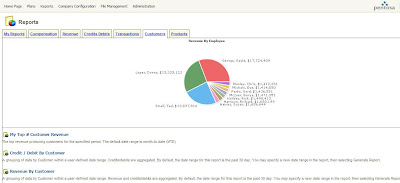
Implementation
Overall the user interface was very nice, but the big question remaining was, how easy is it to implement and maintain solutions built with PlanIt. Not surprisingly the answer was, the implementation is user friendly. It is all done through a user interface and does not require any deep technical skills.
What I particularly liked about the Plan Design interface is its ability have approved plans and plans awaiting approval. I have not seen this functionality in other applications I am familiar with.
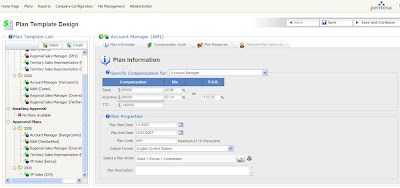 Mobility Feature
Mobility FeatureOnly a week ago I discussed Varicent's mobility feature and I said I hadn't seen this anywhere else; PlanIt is actually available for use on PDA's including Blackberry handsets an Palm devices since April 18th. I haven't seen PlanIt mobile or Varicent mobile, but I wouldn't be surprised if most vendors followed with a similar feature.
Stevie Award for Sales Compensation Program of the Year
In 2006 and 2007, major clients of SRG won the prestigious Stevie Award for Sales Compensation Program of the Year.
Conclusion
In conclusion, I was a bit surprised I hadn't heard about Sales Resource Group before being contacted by Matt. However, with the level of maturity I noticed from their application, I would not be surprised if we started to hear more about them.
Monday, May 19, 2008
ICM Testing - Reviewing Results - Part 4
Every ICM application I have implemented offer an interface to browse through the results. This is usually a GREAT tool to troubleshoot and to resolve issues, but it's rarely the best and quickest tool to analyze results in bulk. Fortunately, every ICM application I have seen also have a functionality to export the results. Exporting the results will create a file locally which can then be opened by a program such as Excel or Access for further analysis. I will discuss how to use Excel to review the results, and later I will create another quick tutorial on using Access.
Step 1) Export the Results from your ICM System
Every system has its own way of doing this, but generally this should be doable from the interface and not requiring a database administrator to pull the data from the database (although this can also be done if required).
Step 2) Import the Data in Excel
First, open Excel and click on File->Open. Click on the dropdown menu beside "Files of type" and click on "All Files".
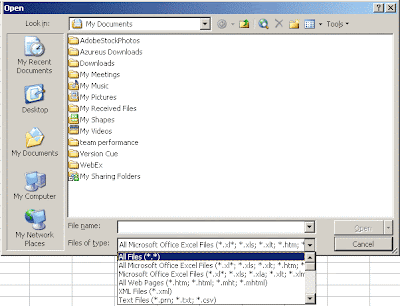 Find the location where you saved the exported file of step 1 and click on "Open".
Find the location where you saved the exported file of step 1 and click on "Open".If the file is a .CSV file, Excel will automatically place the data in columns. If the file is a .TXT file, more steps are required (see step 3).
Step 3: Opening a Delimited Text File in Excel
In the first Wizard step, choose "Delimited" and click on "Next". In Step 2, select the character used to delimit each column (Xactly uses semi-colons). Click "Next" twice and the data will be imported in columns.
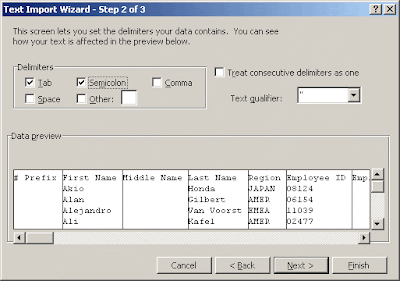
Step 4: Filtering the Result Data
At this point we have a worksheet with all of our result set displayed. Each of the column can be sorted and the search feature can be used to quickly find a specific order. However there is another trick which allows to quickly display data for a specific rule, result name, person, date, etc.
Click on Date->Filter->AutoFilter
This will make the first row (usually column names) dropdown menus which will contain all the values contained within the column. In the example below, the drop-down for column "Currency" allows to choose "USD" and "YEN". Choosing USD will filter out all the other currency types.
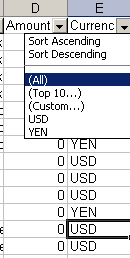
Filtering can be done in this manner for multiple columns at the same time. For example you could filter a certain position (Julien Dionne), and further filter to display only the USD currency.
Quick Summation
Summing credit and commission amounts is one of the most frequent activity I perform when testing.
Excel has a built in feature which allows to quickly find out the sum of selected cells. By simply highlighting the cells containing a number or a dollar amount, the total value of these cells will be displayed in the bottom-right corner of the window.
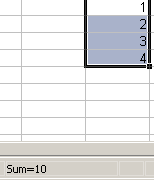
Additional Notes
Excel offers more advanced functionalities such as Pivot Tables. They can be useful when reviewing a large volume of results. I will discuss this in more details in the future.
Excel Limitations
Excel cannot have more than 65536 rows. If the result set exceeds this, it will not get imported. It is possible to "workaround" this issue by only importing a subset of data (maybe by restricting the incentive period). MS Access could also be used instead of Excel and would not be subject to this limit. I will discuss using Access to review results in the near future.
Saturday, May 17, 2008
ICM News This Week
On-Demand Sales Compensation Management Leader Recognized for Providing Exceptional Customer Service
Xactly Analytics: Look at Sales Compensation On-Demand
Xactly, a sales performance management company, recently released Xactly Analytics, an on-demand application designed to provide analysis, metrics, ad-hoc reports and dashboards based on aggregated post-sales data.
Skin in the Game
Centive smoothes away the calluses for a dermatology-product vendor. Thanks to implementing Centive Compel, Obagi Medical:
- increased net sales by 32 percent;
- increased operating income by 56 percent;
- increased net income by 149 percent; and
- added 200 new active physician accounts, an 18 percent increase.
Thursday, May 15, 2008
ICM Test Planning, Scenarios and Templates - Part 3
 In my last post about testing I said that ICM / SPM systems should be tested in phases; the reason for this is that discovering issues late in the development life-cycle could add unexpected delays and ultimately make the budget run over-budget.
In my last post about testing I said that ICM / SPM systems should be tested in phases; the reason for this is that discovering issues late in the development life-cycle could add unexpected delays and ultimately make the budget run over-budget.Creating Test Scenarios for a Sales Performance Management System
I believe the most important aspect of testing is the test scenario preparation. I briefly mentioned how creating good test scenarios was particularly difficult with an ICM application because of the volume of test cases it will typically generate. This is unavoidable, but proper planning is required to ensure that tests are not testing the same conditions twice (wasting time) and that all conditions are being tested (not cutting corners).
Creating Test Data
The test data is the data that will be "staged" to test the scenarios. Typically, an order or a combination of orders will be required to test different scenarios. These orders should be created in the appropriate format to be staged and it should be documented which orders test which scenarios. Because of the different testing phases and because test data is often altered or corrupted during testing, it is important for the test data files to be kept together and be readily available to be re-staged when required.
After processing all the test data, all the test scenarios should be tested. That should cover the entire system, and in theory, after completing these steps, the system should have no outstanding defect.
Wednesday, May 14, 2008
The Sales Manager and the Bear
 Once in a while I review the statistics for this blog to find out which keywords people use to find me. Surprisingly, people often find this blog when looking for funny sales compensation jokes. Here is a good one for your enjoyment.
Once in a while I review the statistics for this blog to find out which keywords people use to find me. Surprisingly, people often find this blog when looking for funny sales compensation jokes. Here is a good one for your enjoyment.The Sales Manager and the Bear
A sales manager and an operation manager went bear hunting. While the operation manager stayed in the cabin, the sales manager went out looking for a bear. He soon found a huge bear, shot at it but only wounded it.
The enraged bear charged toward the sales manager, who started running for the cabin as fast as he could. He ran pretty fast but the bear was just a little faster and gained on him with every step. Just as he reached the open cabin door, he tripped and fell flat.
Too close behind to stop, the bear jumped over him and went rolling into the cabin. The sales manager jumped up, closed the cabin door and yelled to his friend inside, "You skin this one while I go and get another!"
Source: http://www.workjoke.com/projoke60.htm (Not all jokes here are politically correct)
Tuesday, May 13, 2008
Common Pitfalls in Sales Compensation Design
 Today I attended the "Common Pitfalls in Sales Compensation Design" webinar, hosted by Makana Solutions, featuring guest speaker Donya Rose, Founding Partner of the Cygnal Group, a sales compensation consulting company.
Today I attended the "Common Pitfalls in Sales Compensation Design" webinar, hosted by Makana Solutions, featuring guest speaker Donya Rose, Founding Partner of the Cygnal Group, a sales compensation consulting company.Monday, May 12, 2008
Measuring Sales Force Performance (KPI)
 Google "Key Performance Indicator" and you will find enough KPI information to feel dizzy. It is important to know the difference between a performance indicator - some metric that we want to track - and the "key Performance Indicators" - or the most crucial performance indicators, those on which people are generally compensated on.
Google "Key Performance Indicator" and you will find enough KPI information to feel dizzy. It is important to know the difference between a performance indicator - some metric that we want to track - and the "key Performance Indicators" - or the most crucial performance indicators, those on which people are generally compensated on.A recent article “Measuring Sales Force Performance” at gulfnews.com gives a few examples of performance indicators.
Customer and product related Measures:
- Number of new customers acquired
- Sales by product
- Sales by customer segment
- New product sales
Process Measures:
- Productivity
- Channel mix
- Turn-around time
- Number of calls made
- Number of prospects generated
Financial Measures:
- Sales value by geography
- Profitability
- Cost of acquisition
- Attrition
- Book growth
- Fee Income
Measuring metrics is one thing, but interpreting all the data collected is essential and usually the biggest challenge. There are a lot of industry benchmarks that can be used as indicators of how the company is performing compared to their competitors. Measures can also be compared against some framework, analyst point of view or analytics.
However I think the author of the article is entirely correct when he says that internal benchmarks are better because “they tell you what the best team can do in the same situation”. I think that performance indicator’s most valuable insight comes from comparing the metrics against historical data.
Saturday, May 10, 2008
In the News this Week...
ForceLogix, the leading provider of sales performance management optimization solutions, has released a best in class sales coaching module designed to support all sales methodologies worldwide.
Callidus Software Inc (NASDAQ:CALD) to Present at Wedbush Morgan Securities Management Access Conference for Micro-Small-Mid-Cap Companies
Callidus Software Inc (NASDAQ:CALD) will present at the Wedbush Morgan Securities Management Access Conference for Micro-Small-Mid-Cap Companies on Wednesday, May 21 at 12:00 pm. Interested parties may access the presentation by registering for the event at wsw.com/webcast/wedbush6/register.aspx.
Xactly Wins 2008 CRM Excellence Award
Xactly Corporation, the leader in on-demand sales performance management, today announced that Technology Marketing Corporation (TMC)'s Customer Interaction Solutions(R) magazine has named Xactly's flagship application, Xactly Incent, a recipient of the 2008 CRM Excellence Award.
Dreamforce Europe: Benioff, Cloudy CIOs and sophisticated Europeans
Salesforce.com's inaugural European user summit landed in London this week. It was an important gig for the software as a service firm and attracted over 2,000 attendees. So how did it fare?
Upcoming Webinar:
Ventana Research: Sales Performance Management: Improving the Performance of Sales Organizations to Maximize Strategic Value
Here are some key questions that will be addressed in the research:
• What helps organizations improve maturity of their sales organizations and processes.
• Where organizations are investing into information and metrics to improve sales performance.
• Why the reliance on spreadsheets in 47% of companies are a problem and 51% rank scattered information as top impediment to improving sales performance.
• What are the top systems that are required to integrate with sales compensation and operations.
• What is the role of finance and executives for adopting sales performance management.
New Blog:
The Management Curve - How Technilogy is Changing the Way Sales is Managed
The Management Curve is a blog by Paul McCord about technology and the change it is currently and will continue to bring about in how salespeople and the sales function are managed.
Thursday, May 8, 2008
ICM Testing – Part 2: Test Phases and Traps
 ICM systems, as every other software system, should be tested in phases. Here are the major test phases (there can be more or less depending on the complexity and size of the project)
ICM systems, as every other software system, should be tested in phases. Here are the major test phases (there can be more or less depending on the complexity and size of the project)Unit Test: Performed by the developer to ensure a specific component performs as per the requirements. Unit tests should be performed as the system is being built.
System Test (ST): While unit testing was performed with only a single rule, system testing tests entire plans. It ensures the entire system performs as expected and as defined.
System Integration Test (SIT): An ICM system often relies on receiving data from other existing systems. For example, it may expect a file received via FTP, from an ETL process or fetch data directly from a CRM system such as SAP or Peoplesoft. SIT will ensure the systems interact the way they should.
User Acceptance Testing (UAT): Once the ICM system is fully tested by the implementers, UAT is when the business user or owner of the system test and review the results of the system. UAT should be performed on the production system, with production-like data.
Other very important tests which should be performed during ST, SIT and UAT include:
Performance Testing: This test confirms if the processing of commissions can be performed within the required window.
Stress Testing: This test verifies how the system behaves if the data load is higher than expected. For example, the compensation data may increase year over year, or may be higher during quarter end, year end.
Regression Testing: Every time a system is altered, there is a risk for a defect to be introduced. Relevant tests should be performed again to ensure the system still works as expected.
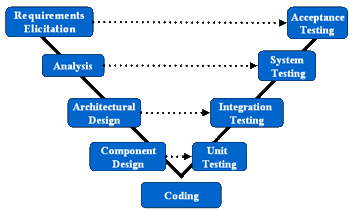
Each of those test phases are usually done in parellel to major development life cycle activities - the "V-model" above illustrates this. I will have to keep the development phases discussion for the future but yes, the left part of the "V" is also necessary.
When working with an implementation partner or vendor, the client is usually mostly responsible for the User Acceptance Testing which I will discuss in more details later.
What I must stress as being extremely important is that it cannot be taken for granted that the implementer will necessarily have a rigorous testing methodology and ethics. To avoid having big surprises when reaching UAT, the client should keep an eye on other testing activities and ask for regular status updates.
Another common trap is that getting regular status updates may not be enough. It is important for the project team to design and agree on the test cases and test plan early on. In larger implementations this is often a step which should get a sign-off. This will ensure the implementers know what the expected results should be, which is very different than the implementers assuming they know what these results should be.
Wednesday, May 7, 2008
YAWN… ICM Testing – Part 1: Introduction
 Testing is a quality assurance process required to ensure the system works as expected and as defined. I never met anyone who found testing “sexy”, fun, or even interesting. However, it is essential!
Testing is a quality assurance process required to ensure the system works as expected and as defined. I never met anyone who found testing “sexy”, fun, or even interesting. However, it is essential!No matter how well designed the compensation plans are, if the commission and bonus results are not correct, the implementation will be a failure. We discussed that it is important for payees to be able to correlate their rewards to their performance, but mistakes could prevent them from doing this efficiently. Another result of “bugs” or system defects will be an increased number of complaints from the payees which will consume the compensation team’s time. These errors will also add confusion, making sales people unhappy and ultimatly lead to a lost of confidence in the system.
Traditionally, testing was a task done only once the entire implementation was completed; you built the system, you tested it and you rolled it out. This is one of the best recipes for failure. Test planning should be done at the very beginning of the project and testing performed throughout the development of the system, until it is rolled out.
Testing an ICM system is particularly challenging because of the volume of different cases. A “standard” software system testing may have a test that if a button is clicked, an action will be performed. With an ICM system, every plan, every rule, and every formula should be tested. For example, if there are four quarters, each quarter using its own rate table, each rate table having 8 tiers, and each tier corresponding to a formula, there will be 32 individual formulas to test – 32 test cases.
In my next posts I will discuss many testing related topics including the different test phases, how to create proper test cases and test plans, and how to review results in Excel and in Access.
Tuesday, May 6, 2008
Varicent SPM 5.0 - Interview with Varicent
 I know I said I would only present industry news once a week, but I wanted to take a moment to discuss the availability of Varicent’s SPM solution - SPM 5.0. I want to talk about this because I’ve received a few questions about it, and especially because following a good conversation with Kelley Kassa, Director of Corporate Communications and Rod Radojevic, Vice President Product Marketing I can offer a bit more information.
I know I said I would only present industry news once a week, but I wanted to take a moment to discuss the availability of Varicent’s SPM solution - SPM 5.0. I want to talk about this because I’ve received a few questions about it, and especially because following a good conversation with Kelley Kassa, Director of Corporate Communications and Rod Radojevic, Vice President Product Marketing I can offer a bit more information.Varicent SPM 5.0 is its flagship solution managing incentive compensation and sales performance. As with every other SPM solutions on the market, the value proposition is clear; Varicent SPM can predict costs associated with new plans, reduce errors, save time, reduce dispute resolution and administrative time of sales professionals, etc. More importantly, it can help out addressing the gaps existing between different business areas and departments.
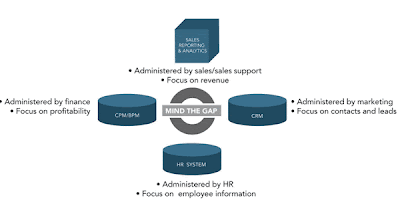 I had never seen Varicent SPM solution before this overview. It seems like most of the changes were done with the business user in mind.
I had never seen Varicent SPM solution before this overview. It seems like most of the changes were done with the business user in mind.  A new module called Composer was also introduced to this release. Rod pointed out that this module makes it easy for business users to set-up, manage and show rules and data flows. This workspace can give insight over calculations, territory assignments, credits, adjustments, overlays and exceptions. Rod added that the workflow appearance of this workspace makes it non-intimidating for anyone to jump-in and review the system.
A new module called Composer was also introduced to this release. Rod pointed out that this module makes it easy for business users to set-up, manage and show rules and data flows. This workspace can give insight over calculations, territory assignments, credits, adjustments, overlays and exceptions. Rod added that the workflow appearance of this workspace makes it non-intimidating for anyone to jump-in and review the system.

I asked Rod what makes Varicent SPM different from its competitors. We talked about its open architecture, its web analytics and reporting capabilities, its flexibility, scalability, and robustness. Rod also mentioned how Varicent was the first product to be a complete SPM solution, but I've seen this claim made by most other companies.

Overall, Varicent SPM 5.0 appeared to be very user-friendly and flexible, and seems to offer everything I would expect from an SPM solution.
If you have any other questions, please send them to me and I will gladly get an answer for them.
Monday, May 5, 2008
ICM Solution Return on Investment - Ask the Expert #4
David's Answer:
It’s a mystery. Since no one can conduct a double-blind test to confirm the value of sales compensation, we live in the world of anecdotes and observable behavior changes. My test of program effectiveness is the degree of “alignment” between product divisions and buyer/sales segments. The sales compensation program should ensure alignment of field efforts between these two moving parties.
What I have to say:
I talked about ICM ROI for the first time here, and discussed another story here. I agree with David that it is hard to assess if the new system is responsible for new behaviors. Taking this further, it is hard to assess whether a compensation program improves behaviors period.
However, assuming that a company does see benefits in an incentive program, the question is, will an ICM/SPM solution pay for itself. Presumably, positive behaviors are already encouraged by more labour incentive variable compensation. Real-time information, dashboards, accurate reporting and advanced analytics may help out sales people and management, but other factors are easier to quantify.
These factors are likely to depend a lot from one company to another. As I pointed out in the previous posts, some of the factors to consider are the implementation, licensing and upkeep costs, the quality of the existing system (how accurate it is), and the potential time saving to be realized with a new system (time spent calculating commissions, reviewing data, resolving issues, etc).
Friday, May 2, 2008
In the News this Week...
In the News this Week:
Xactly Corporation Secures $30 Million to Cement Leadership Position in Sales Performance Management
Varicent Reduces Costs of Managing and Maintaining Sales Performance Management and Incentive Compensation Management With Latest Release of Varicent SPM
Upcoming Events:
Common Pitfalls in Sales Compensation Plan Design (by Makana Solutions)
Blog Search
Subscribe
Other Resources
Blog Archive
-
▼
2008
(99)
-
▼
May
(18)
- Xactly Incent 4.0 - Effective Dating and Other New...
- Enterprise Incentive Management News
- Networking 2.0 - The Art of Making Connections
- For Love or Money: Social vs Monetary Reward
- SPM Testing Template - Part 5
- PlanIt: Another On-Demand Sales Performance Solution
- ICM Testing - Reviewing Results - Part 4
- ICM News This Week
- ICM Test Planning, Scenarios and Templates - Part 3
- The Sales Manager and the Bear
- Common Pitfalls in Sales Compensation Design
- Measuring Sales Force Performance (KPI)
- In the News this Week...
- ICM Testing – Part 2: Test Phases and Traps
- YAWN… ICM Testing – Part 1: Introduction
- Varicent SPM 5.0 - Interview with Varicent
- ICM Solution Return on Investment - Ask the Expert #4
- In the News this Week...
-
▼
May
(18)
Tags
- Sales Performance Management (34)
- Incentive Compensation (27)
- Callidus (19)
- Xactly (17)
- Industry News (15)
- SaaS (15)
- Sales Compensation (14)
- Incentive Strategy (12)
- On-demand (11)
- Best Practices (10)
- Centive (9)
- Case Study (8)
- Webinar (8)
- Varicent Software (7)
- Applications (6)
- Compensation Plans (6)
- ICM (6)
- Incentive Compensation Management (6)
- Pros and Cons (6)
- David Cichelli (5)
- IT offshoring (5)
- News (5)
- Technical Tips (5)
- Testing (5)
- Accenture (4)
- Enterprise Incentive Management (4)
- Implementation (4)
- OpenSymmetry (4)
- RFP (4)
- Return on Investment (4)
- Synygy (4)
- Variable Compensation (4)
- outsourcing (4)
- Analytics (3)
- Ask the Expert (3)
- Consultant (3)
- Funny (3)
- Humor (3)
- IT outsourcing (3)
- Information (3)
- Makana (3)
- Performance Measurement (3)
- Procurement (3)
- Research (3)
- SalesForce.com (3)
- nGenera (3)
- Banking (2)
- Bonus (2)
- Compel (2)
- Excel (2)
- Gartner (2)
- Greg Livengood (2)
- Ice-breaker (2)
- Implementation Partner (2)
- Incentive Plans (2)
- Merced Systems (2)
- Offshore (2)
- On-premise (2)
- Opinions (2)
- Personal Story (2)
- Practique Associates (2)
- Review (2)
- SPM (2)
- Sales Resource Group (2)
- SuccessFactors (2)
- Template (2)
- "Canadian Professional Sales Association" (1)
- "Dig your Well before you're Thirsty" (1)
- "Don Tapscott" (1)
- "Effective Dating" (1)
- "Harvey Mackay" (1)
- "Incent 4.0" (1)
- "Jay Somerset" (1)
- "Keith Ferrazzi" (1)
- "Never Eat Alone" (1)
- AskJon (1)
- BSG Alliance (1)
- Benefits (1)
- Blog (1)
- Book Review (1)
- Boutique Consulting (1)
- Bradford Smart (1)
- Business Process Reengineering (1)
- CPSA (1)
- Challenges (1)
- Coaching (1)
- Compensation Architect (1)
- Competency Management (1)
- Configuration Management (1)
- Consulting (1)
- Contests (1)
- Cygnal Group (1)
- Dashboard (1)
- Deployment Checklist (1)
- Donya Rose (1)
- EIM Software (1)
- Effective Dating (1)
- Enterprise 2.0 (1)
- Eran Carmel (1)
- ForceLogix (1)
- Gary Harpst (1)
- Global Workforce (1)
- Glossary (1)
- Go-live (1)
- Greg Alexander (1)
- HCM (1)
- HR Carnival (1)
- ICM Solution (1)
- Iconixx (1)
- In-house Development (1)
- Incentive Compensation Glossary (1)
- Insurance (1)
- Integration (1)
- Interviewing (1)
- Jeff Kaplan (1)
- Job (1)
- Job Evaluation (1)
- Jon Ingham (1)
- Jon Walheim (1)
- Julien Dionne (1)
- KPI (1)
- Leapcomp (1)
- Livengood Consulting Group (1)
- Maintainability (1)
- Management (1)
- Methodology (1)
- Metrics (1)
- Migration (1)
- Motivator (1)
- Naming Convention (1)
- Networking (1)
- Offshore Communication Challenges (1)
- Offshoring Information Technology (1)
- Optimization (1)
- Oracle (1)
- PPM (1)
- Paul Tjia (1)
- Pervasive Performance Management (1)
- Plan Design (1)
- PlanIt (1)
- Prediction (1)
- Press Release (1)
- Professional Networking (1)
- R (1)
- Reporting (1)
- SPM Question (1)
- Sales Performance Management Outsourcing (1)
- Santorini Consulting (1)
- Six Disciplines Execution Revolution (1)
- Spiff (1)
- Sungard (1)
- THINKStrategies (1)
- Talent (1)
- Terminology (1)
- TextPad (1)
- Topgrading for Sales (1)
- Towers Perrin (1)
- TrueTarget (1)
- Truecomp (1)
- Tutorial (1)
- Vendor (1)
- Ventana Research (1)
- Version Control (1)
- Visa (1)
- Wikinomics (1)
- competitive advantage (1)
- sales rep (1)
About Me

- Julien Dionne
- Ottawa, Ontario, Canada
- Julien Dionne is a well-rounded consultant with global business management experience and outstanding technical, business and leadership skills. He earned a Bachelor of Applied Science in Software Engineering from the University of Ottawa, Canada, and he is a member of the Canadian Professional Sales Association. The views posted within this blog do not reflect the views of Julien’s current or previous employers and clients. Julien can be reached at julien.dionne@gmail.com










